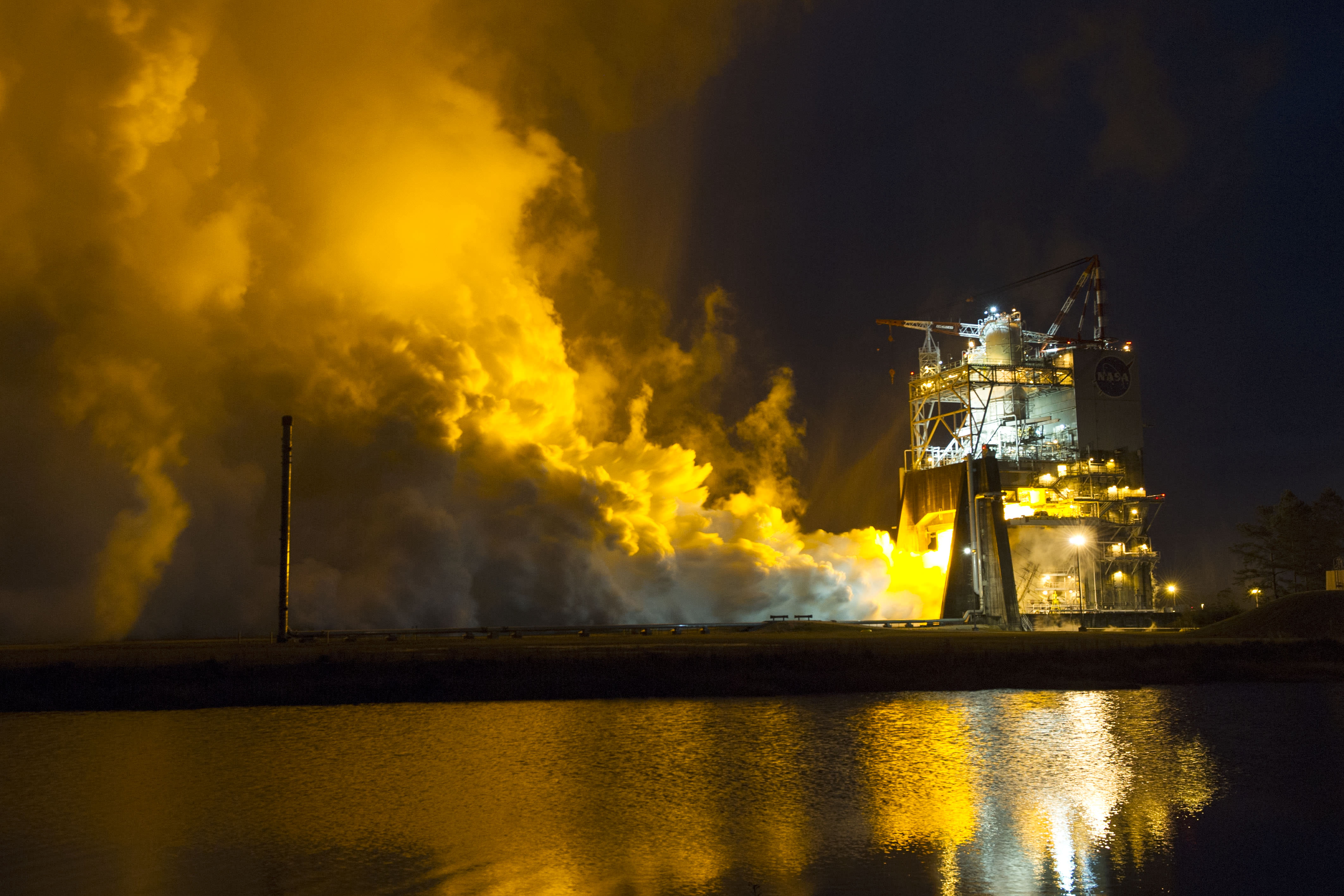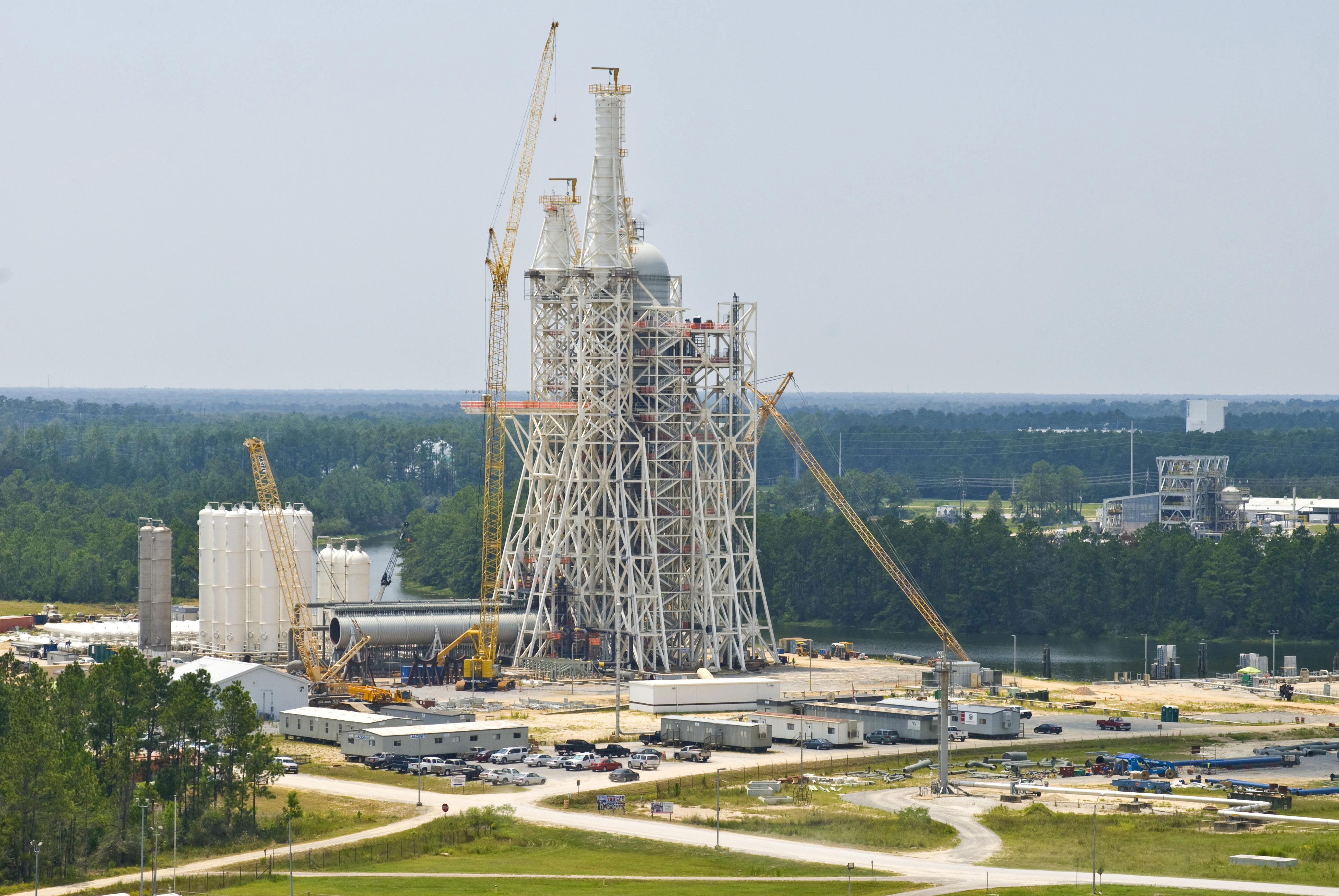Mississippi Stennis Space Center - John C. The Stonish Space Shuttle (SSC) is a NASA rocket test facility in Hancock County, Mississippi, United States, on the Pearl River on the Mississippi-Louisiana border. As of 2012
, which is NASA's largest rocket engine test facility. More than 50 local, state, national, international, private and public organizations and institutions use SSC for their rocket test facilities.
Mississippi Stennis Space Center

NASA's initial requirements for the proposed rocket test facility called for it to be located between the rocket manufacturing facility at the Michwood Assembly Facility east of New Orleans, Louisiana, and the launch facility at Knedy Space Cter, Florida. Additionally, barge access to the site was required because the rocket stages for Apollo were too large to be transported by land. Additionally, the Apollo engines were too loud to be tested at the existing test stand at the Marshall Space Flight Center near Huntsville, Alabama. A more isolated site is needed.
Stennis Space Center Completes Upgrade Of Critical Test System
After an exhaustive site selection process that included a review of Eglin Air Force Base in Florida and other coastal sites including the Caribbean and Pacific Islands, NASA announced the construction of the Mississippi Test Facility (now Stnis Space Cte) on October 25. r), 1961, Experimental Engines for the Apollo Program. Choose High Terrace on the East Pearl River in Hancock County, Mississippi. NASA tasked the US Army Corps of Engineers with the difficult task of acquiring each parcel either by purchasing the land outright or by obtaining a permanent easement.
The selected area was sparsely populated and met all other requirements; However, five small communities (Gainesville, Logtown, Napoleon, Santa Rosa and Westonia), plus a sixth (Pirlington) and a total population of 700 families would have to be completely evacuated. facilities. The effort resulted in more than 3,200 private parcels of land - 786 homes, 16 churches, 19 shops, three schools and various commercial buildings including nightclubs and community centers. Remnants of the community still exist in facilities including town streets and a one-room schoolhouse.
) site was selected on October 25, 1961 at the Mississippi Test Facility or Pearl River Station. On December 18, 1961, NASA officially designated the facility as the NASA Mississippi Test Operation. 125,000 acres (506 sq km) around the test area (officially known as the charging area).
) acoustic buffer. The facility's massive concrete and metal rocket propulsion test stand was originally used for testing the first and second stages of the Saturn V rocket. On July 1, 1965, the facility was reintegrated as the Mississippi Test Facility as part of the Marshall Space Flight Center.
First Sls Engine Blazes To Life In Mississippi Test Firing Igniting Nasa's Path To Deep Space
Beginning in 1971, all Space Shuttle main engines are certified for flight on Saturns. On June 14, 1974, the site was zoned as the National Space Technology Laboratory, a designation it held until May 20, 1988, when Mississippi scientist and space program supporter John C. was zoned for Nice (John C. Stonis).
With the end of the Apollo and Space Shuttle programs, base use declined, with an economic impact on surrounding communities. Over the years, other government agencies and commercial entities have moved in and out of the facility, balancing important economic benefits to the community.
Aerial photo showing the three NASA Space Cter (SSC) test complexes - the E Test Complex (foreground), the three A Test Complexes (center) and the B Test Complex (back).

The Rocket Propulsion Test Complex is a rocket test complex built in 1965 by John C. Stonis was built as an integral part of the space sitter. The Rocket Propulsion Test Complex played an important role in the development of the Saturn V rocket. The A-1, A-2 and B-1/B-2 Test Stands were declared a National Historic Landmark in 1985.
File:nasa Stennis Test Complexes On Display.jpg
The smaller two of the original three test stands, the A-1 and A-2 test stands, were used to test and flight-prove the Saturn's second stage, S-II (pronounced "ess two"). Launch vehicle of the Apollo program. Both stands are similar steel and concrete structures, about 200 feet (61 m) tall, capable of withstanding thrust loads of more than 1 million pounds and temperatures up to 6,000 °F (3,320 °C). In addition to supporting liquid, gaseous helium (GHe), gaseous hydrogen (GH2) and gaseous nitrogen (GN2) as purge or pressurized gases, each test rig can also be supplied with liquid hydrogen (LH2) and liquid oxygen (LOX).
Construction began in 1963 and was completed in 1966. A test complex includes a test control center, observation bunkers and various technical and support systems.
On April 23, 1966, the A-2 test stand crew successfully completed a 15-second captive shot of the S-II-T structural and dynamic test vehicle for the second stage of the Saturn V. This is the first test of the flight weight S-II class. The stage is the largest and most powerful liquid oxygen-hydrogen stage known, with five Rocketdyne J-2 engines producing one million pounds of thrust. The test also marked the first operational use of the A-2 stand.
The first fully sustained fire in the S-II flight stage occurred on May 20, 1966, when the S-II-T A-2 test stand fired for 354.5 seconds. The LOX cutout sensor automatically initiates the cutout. The launch passed all major test objectives except the propellant usage procedure. This is the fourth static shot of the S-II-T. The stage's five hydrogen-oxygen fueled J-2 engines produced a million pounds of thrust.
Mississippi's Stennis Space Center To Play A Critical Role In Nasa's Next Mission To The Moon
On May 28, 1966, a static test version of the second stage of the Saturn V, S-II-T, exploded during a stress test at SSC, injuring five North American aircraft technicians supervising the test. The hydrogen fuel tank failed under pressure during the accident. The S-II-T, which has five oxyhydrogen J-2 engines capable of producing 1 million pounds of thrust, was tested for ground fire on May 25, but stopped firing after 195 seconds because a hydrogen connection leaked. One is cut off automatically. . Technicians were trying to determine the cause of the hydrogen leak during the explosion. There was no hydrogen in the tank at the time of the explosion. At the direction of MSFC, Knedy Space Cter Director Dr. Kurt H. An inquiry committee headed by Devas met on the evening of 28 May. The switch was off and an attempt was made to pressurize the tank. Technicians believed liquid hydrogen was leaking from the VT valve and blocked the valve, shutting down the facility. As a result, the car's fuel tank gets over-pressured and bursts. On May 30, 1966, the commission released its findings after two days of investigation. Class S-II fuel tank pressure exceeds design limits. MTF test procedures require strict controls. After the S-II-T was destroyed, NASA extended the S-II fighter program until July 1967.
On July 31, 1966, S-II-1, the first S-II class aircraft assigned to fixed fire at the MTF, left Seal Beach.
On August 13, 1966, the first flight model of the second stage of the Saturn V rocket (S-II-1) arrived at MTF, completing a 4,000-mile flight from Seal Beach. Workum immediately moved the stage to the S-II Phase Services and Inspection Building for inspection and static shot preparation.

On December 1, 1966, North American Airlines successfully performed a 384-second captive ignition of five J-2 engines, the first hydrogen fueled engines, producing a total of 1 million pounds of thrust. During the test, the SLAM weapons of Machines No. 2 and No. 4 did not fire, so only Machines No. 1 and No. 3 successfully gimbaled. The test included nearly 800 measurements of record-level performance, including propellant tank temperature, engine temperature, propellant flow rate and vibration.
New Bill Aims To Grow South Mississippi's Space Industry
On December 30, 1966, MSFC technicians at the MTF test stand performed a static ignition of the first flight version of the Saturn V's second stage, S-II-1. This second test, like the previous one, lasted just over six minutes.
On January 27, 1967, the S-II-2 stage departed Seal Beach, California, transiting the Panama Canal to MTF. After a 16-day journey, the S-II will arrive at the MTF for two static tests. The S-II-2 class arrived at MTF's dock on February 11, 1967. The S-II-2 stage was part of the second Saturn V launch vehicle (AS-502) planned for launch from KSC in late 1967 and scheduled for testing at MTF in late March 1967.
On 17 February 1967, the first full-time test of the upgraded J-2 engine cluster, S-II Battleship Test No. 041, lasted 360 seconds.
On February 25, 1967, Workcom completed construction of the S-II A-1 test bed and the Corps of Engineers assumed official possession without exception.
Stennis Space Center Cuts 129 Jobs As Part Of Consolidation
On March 31, program officials aborted the first attempt at static ignition in the S-II-2 stage due to failure to close the pre-valve.
Battleship testing of the S-II battleship test phase with five upgraded J-2 engines took place in late March 1967 with a total duration of approximately 360 seconds of main phase operation.
Two experimental rigs tested and flight-certified the S-II class and J-2 engines

Us navy petty officer uniform, us navy officer dress uniform, royal navy officer uniform, navy officer white uniform, ww2 navy officer uniform, navy officer wedding uniform, russian navy officer uniform, navy medical officer uniform, navy officer uniform, us navy officer uniform, navy officer dress uniform, navy warrant officer uniform

0 Comments